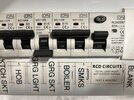Hi  ,
,
Confident and competent DIY'er here with a query about my garage mains, hope someone can help please ??
I had an extension done a couple of years ago, and part of that was a new garage. The qualified electrician did all the wiring, including a new fuse box which lives in the garage. There are 3 x 240v double sockets and I wanted to add a new double socket, so I was checking the the wiring the electrician did. To me, the three double 240v sockets don't look to be a ring main. To me it looks like they are all spurs (see attached diagram) ??
Can I just add another spur, or would it be better if the whole thing was on a ring ?? All sockets would probably never all be in use at the same time.
Cheers

Confident and competent DIY'er here with a query about my garage mains, hope someone can help please ??
I had an extension done a couple of years ago, and part of that was a new garage. The qualified electrician did all the wiring, including a new fuse box which lives in the garage. There are 3 x 240v double sockets and I wanted to add a new double socket, so I was checking the the wiring the electrician did. To me, the three double 240v sockets don't look to be a ring main. To me it looks like they are all spurs (see attached diagram) ??
Can I just add another spur, or would it be better if the whole thing was on a ring ?? All sockets would probably never all be in use at the same time.
Cheers


